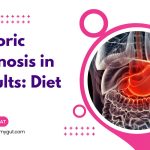5 Duodenal Ulcer Pain Locations and mimics.
Our content is not intended nor recommended as a substitute for medical advice by your doctor. Use for informational purposes only.
1. Commonest duodenal ulcer pain locations.
NOTE: The numbers and frequencies of duodenal and gastric pain locations are derived from Yamada’s Textbook of Gastroenterology version SIXTH EDITION (reference).
A. Epigastric pain location ( in up to 86% of cases).
The commonest duodenal ulcer pain location is the upper central part of your abdomen (called the epigastric area). It lies a few inches above the belly button, just below the rib cage.
This epigastric area is the most common site of gastric and duodenal ulcer pain.
The location of the pain is not a good differentiator of the ulcer location. For example, 67% of gastric ulcers and up to 86% of duodenal ulcer pains are felt in the epigastric area.
Also, the characteristic pain type is often the same in both gastric and duodenal ulcers.
The pain character of duodenal ulcers in the epigastric area is often:
- Burning or
- Gnawing.
- Heaviness or discomfort (dyspepsia).
The typical presentation of duodenal ulcer in the epigastric area include:
- Most duodenal ulcers are entirely asymptomatic (see the third section).
- Pain (burning, or gnawing).
- Bloating is more common among patients with duodenal ulcers compared to gastric ulcers.
- Burning chest pain heartburn is also commonly associated with duodenal ulcers (partially due to associated acid reflux).
- The pain is often partially relieved by eating (unlike gastric ulcer pain, aggravated by eating).
- The pain often starts several hours after eating (unlike stomach ulcer pain which begins shortly after eating).
- The duodenal ulcer is more likely to happen at night (unlike stomach ulcers).
- As food improves the pain, patients with duodenal ulcers always have normal or increased appetite. Consequently, they may gain weight.
B. Duodenal ulcer back pain (in about one-third of cases).
The second common duodenal ulcer pain location is back pain. The back pain location is often in the central midback area opposite the locations of the duodenum.
Up to 31% (about one-third) of patients with duodenal ulcers will have associated back pain.
Duodenal ulcer back pain is rarely isolated. It often occurs in association with epigastric pain.
| Duodenal ulcer pain location | Frequency (%) |
| Epigastric | Up to 86% |
| Right upper abdomen | Up to 17% |
| Left upper abdomen | Up to 5% |
| Radiation to the back | Up to 31% |
| Associated heartburn (in the chest) | 27-59% |
MORE: How Frequent is Back Pain with Duodenal Ulcers?
2. Uncommon locations.R
A. Duodenal ulcer-related chest pain (heartburn).
A burning sensation in the chest (heartburn) is the main symptom of acid reflux or gastroesophageal reflux disease (GERD).
However, patients with duodenal ulcers frequently feel burning pain in the chest.
According to Yamada’s Textbook of Gastroenterology, 27 to 59% of patients with duodenal ulcers complain of heartburn.
The pain is felt as a burning sensation in the chest (behind the breastbone).
The pain may be solely due to a duodenal ulcer or associated GERD.
B. Duodenal ulcer left upper quadrant pain.
The left upper quadrant of the abdomen is also an uncommon location of duodenal ulcers. One in every 20 patients (5%)with duodenal ulcers may feel pain in the left upper quadrant (the right hypochondrium).
Other common causes of pain in the left upper abdomen include:
- Splenic conditions include the enlarged spleen (splenomegaly), splenic abscess, splenic rupture, or splenic infarction.
- Intestinal pain as with irritable bowel syndrome, Inflammatory bowel diseases, and gastroenteritis.
- Left rib cage pain.
C. Duodenal ulcer right upper quadrant pain:
Duodenal ulcer pain may also be located in the upper right upper quadrant of your abdomen (the right hypochondria area).
This area is often related to gallbladder and liver pain. However, between 7 and 17% of duodenal ulcer sufferers may feel pain at this location (reference).
Other causes of right upper quadrant pain include:
3. Fact #1: 70% of peptic ulcers are PAINLESS.
Duodenal ulcers are commonly asymptomatic or have very minimal symptoms. However, one study found that about 70% of patients may have (silent) peptic ulcer diseases.
Having an ulcer in your duodenum doesn’t always mean you will have pain or other symptoms.
Factors that may contribute to (silent peptic ulcer):
- Being obese or overweight.
- Habitual tea drinking.
- Smaller ulcer (less than one centimeter in diameter). Duodenal ulcers tend to be smaller than stomach ulcers, so they are more likely to be asymptomatic.
4. Fact #2: Doctors are less reliant on symptoms to detect ulcer location.
- Most ulcers are asymptomatic.
- No significant differences between the stomach and duodenal ulcer pain locations.
- Only 10% of patients with epigastric pain and dyspeptic symptoms have ulcers.
- Associated symptoms are similar among patients with duodenal ulcers, stomach ulcers, and functional dyspepsia.
- Many other conditions may also overlap, such as chronic pancreatitis, gallstone diseases, GERD, and irritable bowel syndrome.
- Your doctor’s clinical or physical examination is also rarely helpful in detecting ulcers.
The gold standard for diagnosing duodenal ulcers is upper gastrointestinal endoscopy. Your doctor will request an endoscopy if your symptoms are consistent with peptic ulcers and not responding to treatment.
5. Differences between duodenal ulcer and gastric ulcer pain locations and symptoms:
The following table summarizes all the differences between duodenal and stomach ulcers.
| Duodenal Ulcer | Gastric Ulcer |
| The primary pain is in the epigastric area, may spread to the left or right hypochondrium and the back. | The same pain locations and radiations. |
| Often improved by eating. | Often aggravated by eating. |
| Good appetite, with normal or overweight. | Loss of appetite is often associated with weight loss. |
| Pain starts later after eating (two to four hours after meals). | Pain starts shortly after eating (within one to two hours) |
| The pain is often episodic (comes in attacks that are short-lived). | The pain is often persistent for long hours or days. |
| More likely to occur at night (up to 88% of the time). | Less common for the pain to occur at night (up to 48%). |
| Nausea and vomiting are slightly less common | Nausea and vomiting are slightly more common |
| Less likely to turn malignant | more likely to turn malignant (gastric cancer), especially in the elderly. |
| Associated with H. Pylori infection100% of the time. | Associated with H. Pylori infection in 70% of the time |
| When it bleeds, it is more likely to cause hematemesis (vomiting of blood). | When it bleeds, it is more likely to cause melena (black stool). |
- Evidence-based
- Written by a doctor.

Related Posts:
- Typical & Atypical IBS Pain Locations (Diagram Included)
- Fatty Liver Pain: Causes, Mimics, and Treatment;…
- How Do Blood Clots Look Like In Urine (+ Mimics)
- 6 Causes of Left Abdominal Pain When Pressed.
- Liver Pain in Females: Location, Causes, Pregnancy, & More.
- Mid Back Pain (Right Side): 6 Causes & How to Differentiate.






